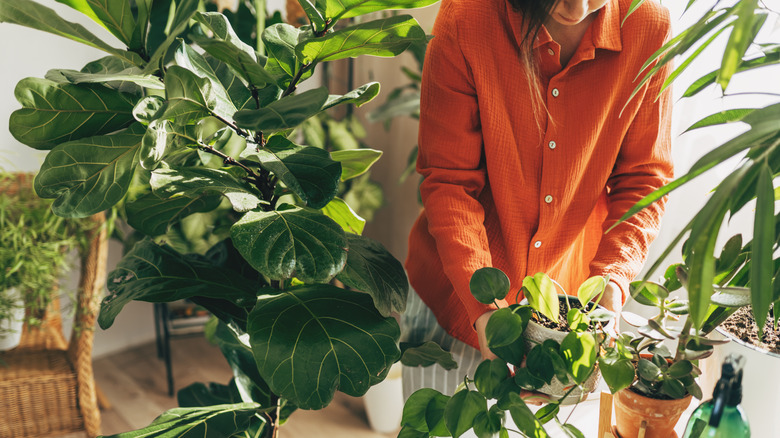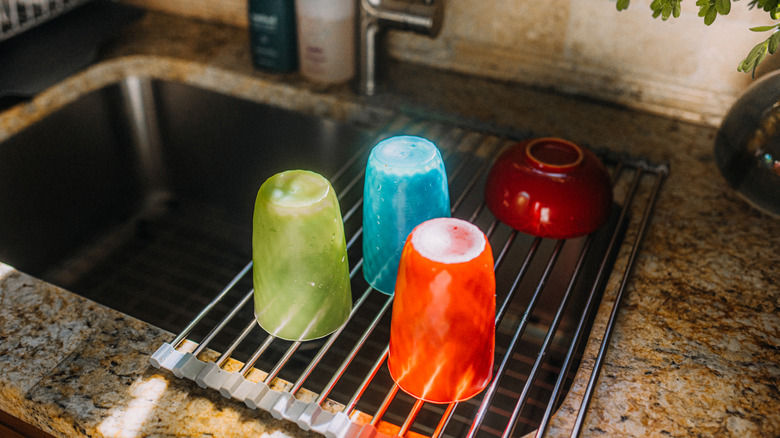The Reason You Should Be Using A Dish Rack To Water Your Plants
We may receive a commission on purchases made from links.
If your indoor plants are giving off a bad smell (hint: that suggests root rot), have mold and mildew covered soil, or are buzzing with tiny insects that suspiciously resemble fungus gnats, the dirt inside their pots is likely way too damp. There's a simple solution to avoid all of these problems; you need to ensure all the water drains out the bottom of your pots completely after each watering. If you want to ensure this happens, a roll-up dish rack could come in handy. Pop it across your kitchen sink to create the perfect spot to water your plants. The mesh-style design allows the water to drain out into the sink, making it far less messy and more efficient than emptying individual saucers or hauling all your houseplants outside for watering. Plus, because it's not fixed in place, it's easy to store when you're not using it.
If you're wondering why proper drainage is so important for houseplants, if water can't flow freely from a planter, it will pool in the soil, creating a low oxygen environment. If you leave a houseplant sitting in water for prolonged periods of time (longer than an hour), the roots will be overwhelmed and the plant may perish from root rot. Signs of overwatering include droopy, yellowing, scorched, or dropped leaves. It's tricky, though, because these can also be signs of under-watering. Test if your plants need water by simply sticking your finger into the soil. If the dirt feels dry, it's time to water. Note, too, that watering houseplants properly necessitates the water coming out of the drainage holes. If it's not, you haven't given them enough water.
Purchase the right kind of rack for effective houseplant sink watering
Many plants are killed by enthusiastic, caring plant parents with overzealous watering schedules. The smaller the pot, the more often you need to water the plant. Likewise, cacti and succulents, plants adapted to arid environments, need far less water and are more prone to the harmful effects of overwatering than their rainforest or tropical counterparts. Indoor humidity also affects how often plants need watering: high humidity will necessitate less watering, while low humidity will dry the soil out faster. If you see the soil pulling away from the planter, your houseplant is well overdue for watering. It's time to implement the sink watering technique!
The kind of dish rack you're looking for is one that fits right over your sink and rolls up for easy storage when not in use. A Merrybox Roll Up Dish Drying Rack won't rust and will cost you just $16. Another alternative is to channel European homeowners and get an overhead dish rack and organizer. The Sakugi Dish Drying Rack costs about $28 and you can use it for storing other sink implements, too. Oh, and here's an idea you might already have lying around: repurpose a cooling rack — you know, the ones you use to cool cookies fresh from the oven. The rack needs to be slightly bigger on all sides than your sink. If you're buying this kind of rack, measure first to make sure you get the right size; most American kitchen sinks are 22 inches long, but the width can vary.
How to water houseplants on a dish rack over your sink
The kitchen sink is a good plant watering spot because it's usually centrally located in the home. However, don't discount a laundry or bathroom sink if you have a small home or those rooms are closest to the majority of your houseplants. Set up the rack, which involves rolling it out or placing it over your sink. Cluster your houseplants together on the rack with as few gaps as possible and water them thoroughly. Leave them to drain into the sink until you can't see any water dripping out, then take them back to their usual spots in your home. You can place a saucer under each pot if you're worried about the odd residual drip staining your floors. Follow good indoor gardening hygiene practices and scrub the rack with warm water and dish soap before you put it away.
If your plants still aren't draining well despite watering them on the rack and leaving them until you can't see any more water dripping out, check the bottom of your pots. It probably goes without saying that you should remove the saucers, since their entire purpose is to collect water. Outside of this simple step, check the drainage holes. If the pot doesn't have holes or the holes are too small, create or widen them with a drill fitted with a diamond tipped hole saw bit. Notice the holes are clogged? If stones are stuck in the holes, remove them. Filling the bottom of planters with stones is a common plant pot drainage 'hack' you should truly avoid trying at all costs.

